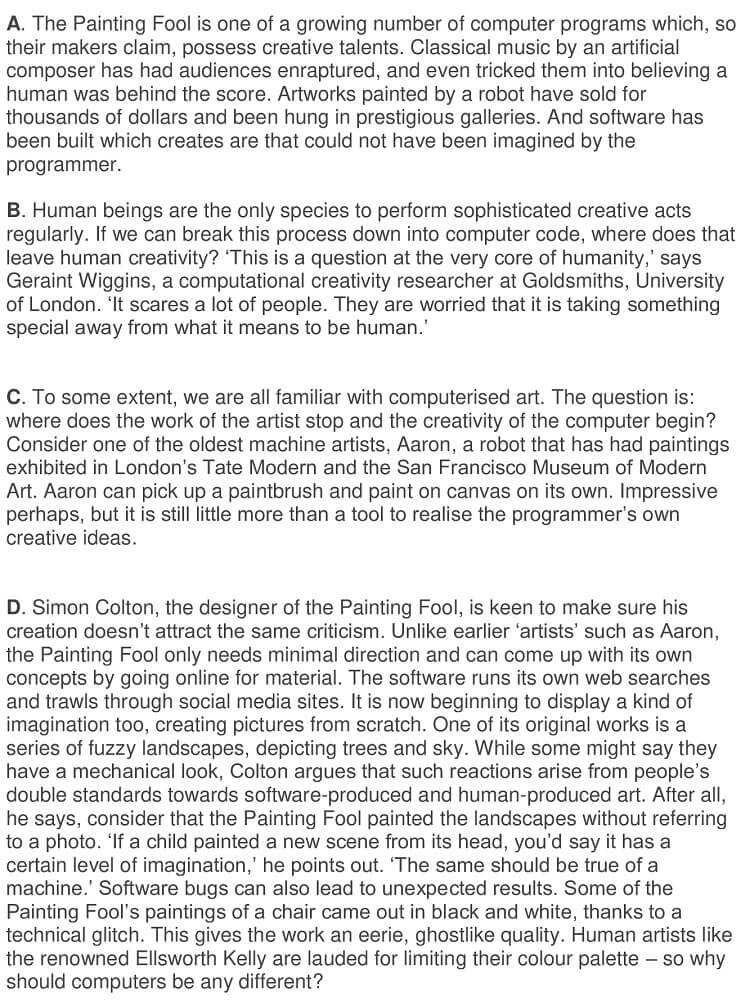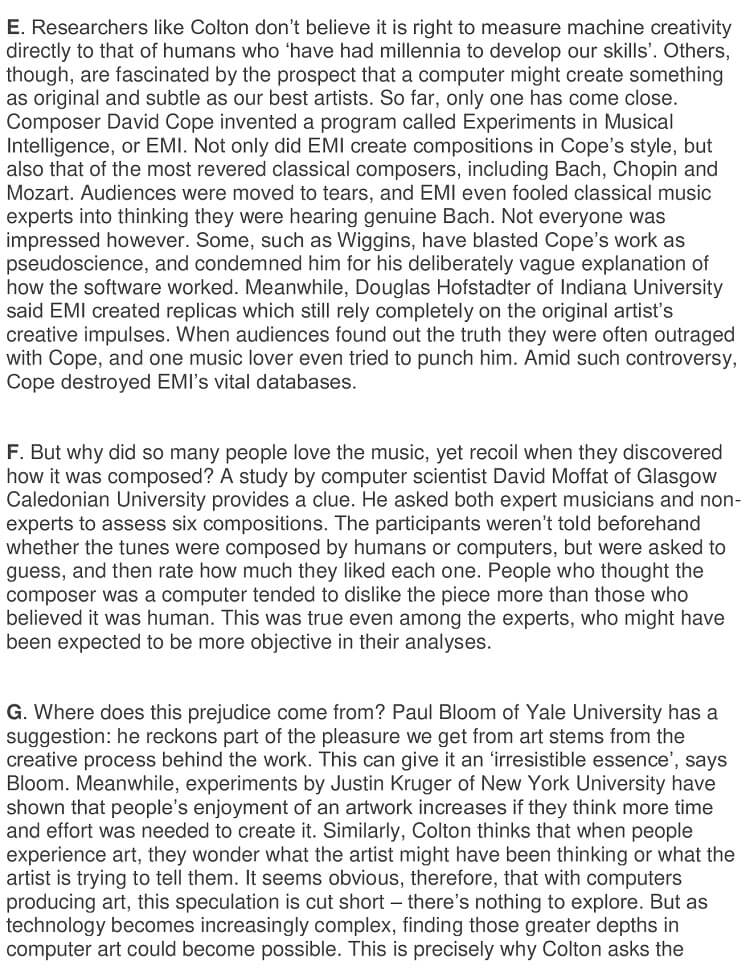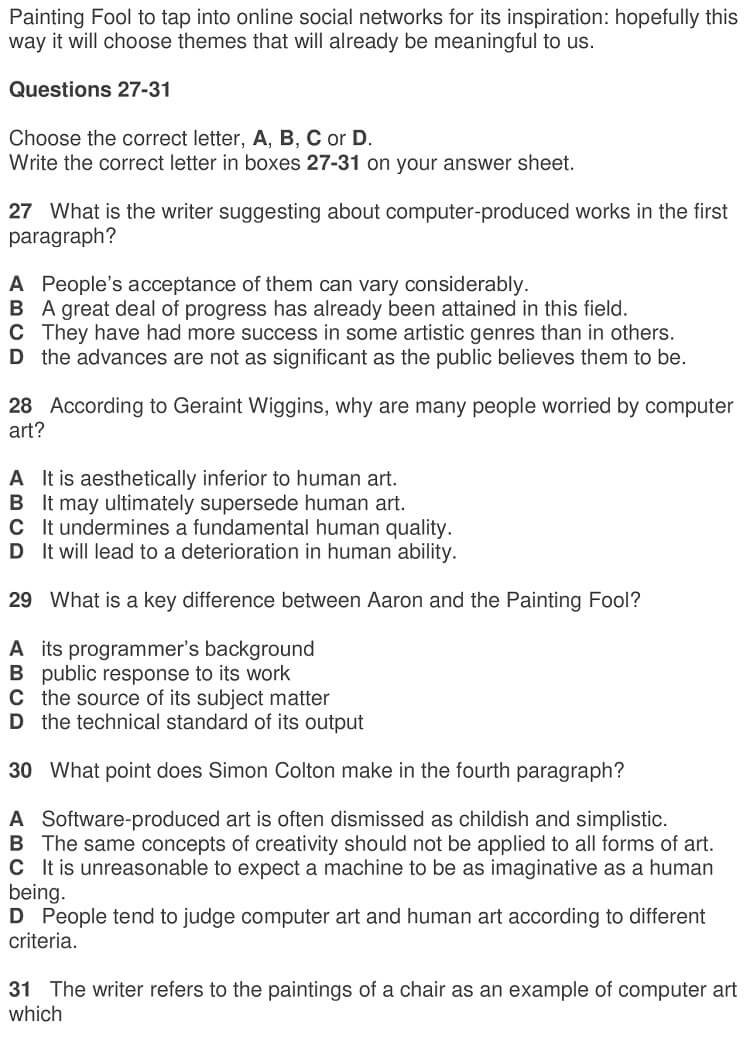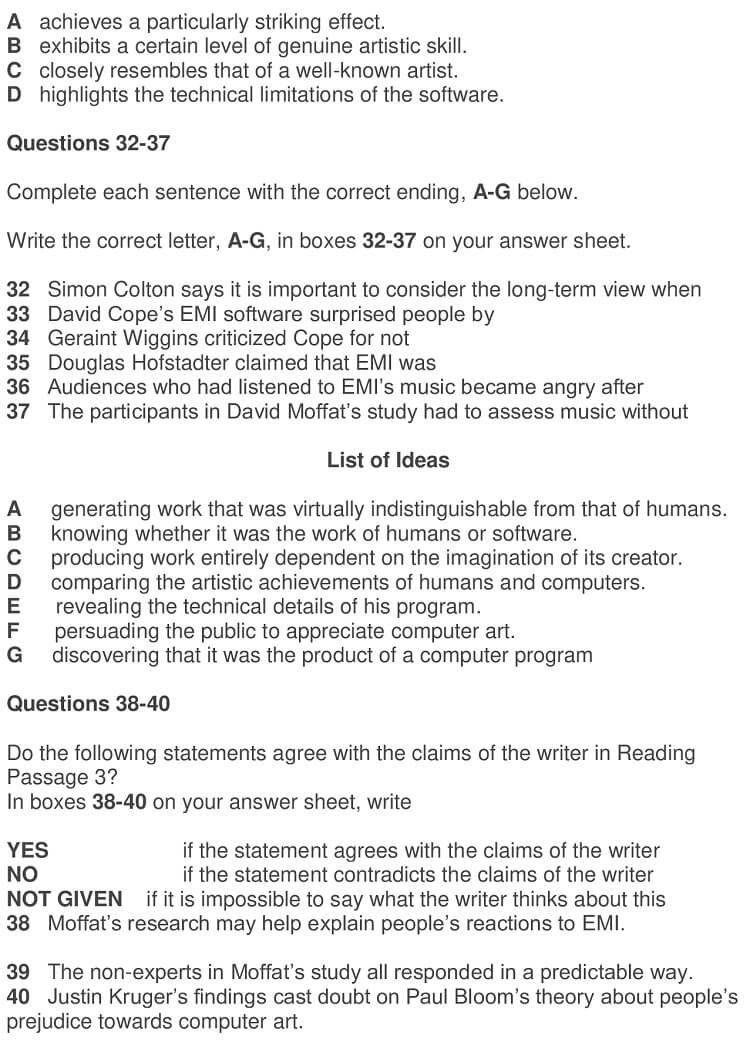Artificial Artists Reading Answers
9 min read
Updated On
-
Copy link
Wondering how to tackle the Artificial Artists Reading Answers? Read our blog for detailed explanations, question type tips, and expert advice!
Table of Contents

Limited-Time Offer : Access a FREE 10-Day IELTS Study Plan!
Artificial Artist is a reading passage from Cambridge IELTS 13 Reading Test 1, making it ideal for IELTS Academic Reading preparation. Ideally, you should not spend more than 20 minutes while practising this passage. If you want more practice, try taking an IELTS reading practice test.
There are 14 questions along with the passage, Two Wings and a Toolkit. The question types found are:
- IELTS Reading Multiple Choice Question (Q. 27-31)
- IELTS Reading Matching Sentence Endings (Q. 32-37)
- IELTS Reading Yes/No/Not Given (Q. 38-40)
Artificial Artists
Can computers really create works of art?




Answers of Artificial Artists Reading Answers With Location and Explanations
Now check out the answers to the questions from the passage in the reading section of IELTS Academic, Artificial Artists, and understand the shortcomings and strengths of your IELTS preparation.
27 Answer: B
Question Type: Multiple Choice Question
Answer location: Paragraph A, Line 1
Answer explanation: In the first paragraph, the introductory line states that “The Painting Fool is one of a growing number of computer programs which, so their makers claim, possess creative talents.” In this sentence, it can be inferred that much progress has already been attained in this field.
28 Answer: C
Question Type: Multiple Choice Question
Answer location: Paragraph B, Line 5
Answer explanation: Through the sentence quoted here from the second paragraph, ‘It scares a lot of people. They are worried that it is taking something special away from what it means to be human.’, the author clearly suggests that humans are worried as it will take away human creativity and attenuate the very essence of being a human and hence would undermine them.
29 Answer: C
Question Type: Multiple Choice Question
Answer location: Paragraph D, Lines 2-5
Answer explanation: “Unlike earlier ‘artists’ such as Aaron, the Painting Fool only needs minimal direction and can come up with its own concepts by going online for material. The software runs its own web searches and trawls through social media sites. It is now beginning to display a kind of imagination too, creating pictures from scratch.” This suggests the key difference between Aaron and Painting Fool in the source of their subject as far as painting is concerned.
30 Answer: D
Question Type: Multiple Choice Question
Answer location: Paragraph D, Lines 7-8
Answer explanation: “While some might say they have a mechanical look, Colton argues that such reactions arise from people’s double standards towards software-produced and human-produced art.” This line suggests that Colton points out that people form a bias and judge computers and humans differently.
31 Answer: A
Question Type: Multiple Choice Question
Answer location: Paragraph D, Lines 12-14
Answer explanation: “Some of the Painting Fool’s paintings of a chair came out in black and white, thanks to a technical glitch. This gives the work an eerie, ghostlike quality,” This line lauds computers for their artistic finesse as it says that it generates a feeling of spookiness and horror.
32 Answer: D
Question Type: Matching Sentence Endings
Answer location: Paragraph E, Lines 1-2
Answer explanation: “Researchers like Colton don’t believe it is right to measure machine creativity directly to that of humans who ‘have had millennia to develop our skills’. This line suggests that we shouldn’t compare computers and humans as humans have achieved the level of perfection over a long period of time, whereas computers are very new and hence, we should be considerate of that fact.
33 Answer: A
Question Type: Matching Sentence Endings
Answer location: Paragraph E, Lines 4-5
Answer explanation: “Audiences were moved to tears, and EMI even fooled classical music experts into thinking they were hearing genuine Bach.” This line suggests that people got emotional while listening to a computer generated music and couldn’t distinguish between an AI music and music by a human.
34 Answer: E
Question Type: Matching Sentence Endings
Answer location: Paragraph E, Lines 9-11
Answer explanation: “Some, such as Wiggins, have blasted Cope’s work as pseudoscience, and condemned him for his deliberately vague explanation of how the software worked.” This suggests that they didn’t like the idea of its misleading nature and considered it to be a false interpretation of science and that Cope was not able to explain the technicalities of how the software worked.
35 Answer: C
Question Type: Matching Sentence Endings
Answer location: Paragraph E, Lines 11-12
Answer explanation: “Meanwhile, Douglas Hofstadter of Indiana University said EMI created replicas which still rely completely on the original artist’s creative impulses.” This line shows that the EMI was not truly independent and that it had to rely upon the imagination of the creator’s mind.
36 Answer: G
Question Type: Matching Sentence Endings
Answer location: Paragraph E, Lines 13-14
Answer explanation: “When audiences found out the truth they were often outraged with Cope, and one music lover even tried to punch him.” This suggests that this incident made audiences enraged upon knowing that they were listening to an EMI generated music and not a natural one.
37 Answer: B
Question Type: Matching Sentence Endings
Answer location: Paragraph F, Lines 3-4
Answer explanation: “He asked both expert musicians and non-experts to assess six compositions. The participants weren’t told beforehand whether the tunes were composed by humans or computers, but were asked to guess, and then rate how much they liked each one.” This suggests that participants didn’t know that they were listening to EMI generated music.
38 Answer: Yes
Question Type: Yes, No, Not Given
Answer location: Paragraph F, Lines 6-7
Answer explanation: “People who thought the composer was a computer tended to dislike the piece more than those who believed it was human. This was true even among the experts, who might have been expected to be more objective in their analyses.” Through Moffat’s study of a group of expert musicians and non-experts who assessed six compositions, we come to know about people’s reaction and how they perceived a machine/artificial talent as opposed to humans’ talents.
39 Answer: Not Given
Question Type: Yes, No, Not Given
Answer location: N/A
Answer explanation: There is no reference about any reaction of the non-experts in Moffat’s study.
40 Answer: No
Question Type: Yes, No, Not Given
Answer location: Paragraph G, Lines 1-5
Answer explanation: “Paul Bloom of Yale University has a suggestion: he reckons part of the pleasure we get from art stems from the creative process behind the work. This can give it an ‘irresistible essence’, says Bloom. Meanwhile, experiments by Justin Kruger of New York University have shown that people’s enjoyment of an artwork increases if they think more time and effort was needed to create it.” This shows that both Bloom and Kruger support the same idea that people like creative aspects of humans and hence, this statement is not true.
Boost your IELTS Reading score by signing up for an Expert Session today!
Tips to Solve the Question Types in Artificial Artists IELTS Reading Answers
As you now know the answers to the Reading Answers of Artificial Artists with explanation, let us look at some quick IELTS exam preparation tips for answering the different types of questions in the passage.
Multiple Choice Questions
It is one of the most frequently asked types of questions that are asked in the IELTS exam. In these types of questions, you are required to choose the most appropriate option out of all the given options, which you believe would be the aptest answer to a particular question. You are generally given four options (the number of options may vary, at times) and you are required to choose the most suitable option. It is advisable to go through all the options before answering them.
- Before reading the passage, read the question and select the keywords. Check the keyword possibilities if the question statement is short on information.
- Then, using the keywords, read the passage to find the relevant information.
- To select the correct option, carefully read the relevant words and match them with each option.
- You will find several options with keywords that do not correspond to the information.
- Try opting for the elimination method mostly.
- Find the best option by matching the meaning rather than just the keywords.
Matching Sentence Endings
In these types of questions, you are required to complete the sentences that are asked by using the sentences given to you in the list of ideas. You are required to go through the paragraph, refer to the question and then pick the sentence in the list that you believe can complete the asked sentence with a suitable ending. Some tips for answering the questions and obtain a high IELTS reading band score are given below:
- The answers will be in the same order as the list of incomplete sentences.
- Use the elimination process to get the correct answer.
- Don’t read the complete text until you have studied the incomplete sentences and the endings.
- Only read the relevant sentences.
- You will have to match meanings and not the exact words. Thus, look for paraphrasing and words.
- You must ensure that the grammatical structure of two halves of the sentence is matching correctly.
Yes/No/Not Given
Unlike True/False/Not Given IELTS Reading questions, in this question type, you have to answer using yes, no, or not given with respect to the statements made. If you believe that the given statement is mentioned in the text, then write ‘Yes’. If you think the statement is wrong, write ‘No’. And, in case you do not find any piece of information regarding the given statement, write ‘ Not Given’. Following the given steps will help you to solve it easily.
- Always begin by reading the question and identifying the keywords. Before reading the material, have a look at your list of Yes, No, and Not Given questions.
- You need to scan the passage for synonyms or paraphrased words of the keywords. Once you have highlighted the keywords, swiftly read the text to look for paraphrases or synonyms.
- Matching highlighted words, or keywords in the questions with their synonyms in the text is the best way to figure out the answer. Once you find both sets of keywords, cross-check them to find the answer.
- Do NOT waste time if you are confused. If the facts match, the answer is YES, and in case it doesn’t match, it is NO. If you are unable to find the answer or unsure of it, mark it NOT GIVEN.
Check More IELTS Reading Answers
Practice IELTS Reading based on question types

Start Preparing for IELTS: Get Your 10-Day Study Plan Today!
Recent Articles

Nehasri Ravishenbagam

Haniya Yashfeen

Haniya Yashfeen

Haniya Yashfeen




Post your Comments